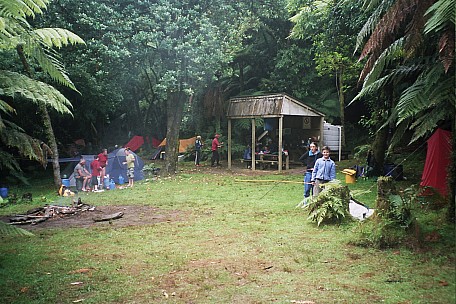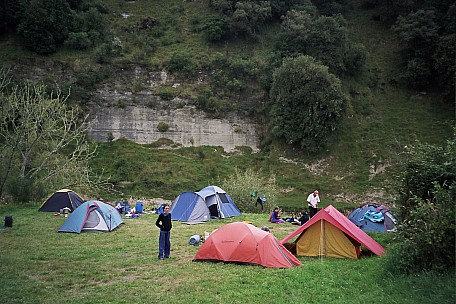for photos pages
for maps page
for photos pages
for main page
for day pages
2007-01-20 Whanganui River < Trips > 2007-06-01 Whakapunake
add main page trail

Day 4-140 08 A 0041 mangawaiiti

Day 1-140 11 A 0062 ohinepane
|
|
|
| Saturday
|
|
Sunday
(22km)
160m asl
|
|
Monday
(31km)
|
|
Tuesday
(30km)
|
|
Wednesday
(22km)
|
|
Thursday
(31km)
|
|
Friday
(12km)
|
|
Saturday
(8km)
|
|
Outline
Starting at Taumarunui this is a "Great Walk(approve sites)" for which fees(approve sites) are payable.
The best rapids are between Taumarunui and Whakahoro (Wades landing), then into the Whanganui National Park(approve sites).
7 days and 6 nights makes for a leisurely trip with the opportunity for two nights in one campsite to pursue swimming, eeling, reading or just lying in the sun.
Visit the Hau Hau poles and falls at the Ohura River (might even camp there), Wades Landing, Man O War Bluff, The Bridge to Nowhere, and The Drop Scene plus lots of stuff in between!
The Whanganui is rated as an 'easy' river with plenty of camp sites and is a really enjoyable experience, the first section passes essentially through farmland, but after Whakahoro it is committing as there is no road access until Pipiriki, so the following is important:
- though a group, individuals are responsible for themselves and their kids
- for safety reasons it is important that people have some idea which way is forward in a canoe and how to use a paddle. At the very least get some prior canoeing practice done at Fergs Kayaks(approve sites), try the Kupe canoe club(approve sites), Hutt Valley canoe club(approve sites), or elsewhere before the trip.
- minimum suggested age is around 10 years (depending on strength and willingness). Younger kids have done the trip as passengers, sitting in the middle, or paddlers, with a reasonably strong adult in the same canoe.
Catering and Food
Trips are self catering.
Bring all your own cooking gear and food.
Lunches are often made in the morning or the night before.
Campsites have water.
Breakfasts x 7, Lunches x 7, Dinners x 6, Snacks, Meat is good for 2-3 days if pre frozen, bacon lasts well if pre cooked
Taumarunui has a New World supermarket.
- WLO(approve sites) at Whakahoro can keep food, with frozen food in a freezer
Gear
- kids may appreciate wetsuits. Togs, rash top, tramping towel.
- boat shoes or rafting sandals are recommended
- tents, sleeping bags, closed cell foam, headlamps or torches (LED recommended), cooking equipment (stove, billies, mug, plates, cutlery, matches or lighter), all the usual suspects.
- warm and windproof clothing, the valley can be cold at night and in southerlies
- rubbish bags to carry out all rubbish
Of course you will bring sun screen, insect repellent, water bottles or bladders, sunglasses, a wide brimmed sun hat with a chin strap, a waterproof parka, and first aid kit.
Tips
- heavy duty dry bags to carry items (food, camera, sunscreen,insect repellent, and clothing) you want to access during the day (30 to 40 litre)
- several slings and karabiners to fasten dry bags, snow foams, camera, map satchels, spare paddle, and other 'loose' items to the canoe
- combined sunscreen/insect repellent recommended, 5 to 10 grams per person per day
- bike gloves are worth bringing if you have them, to protect hands from blisters, or else lots of sticky tape well do the same job.
- bring sticky tape and a permanent pen to name barrels (both lids and body) and gear
- a small groundsheet to pack and unpack onto is very useful
- a rope for a washing line, and a few pegs is a good idea
- a stuff sack to hold water bottle or bladder and fasten to canoe
- small square of closed cell foam to sit on
- barrel organisation: 1 per person for all personal clothing and equipment; tent; kitchen stuff; and food
- check barrel has rubber sealing ring in lid
- bring the Guide to the Whanganui River(approve sites)
Information
|
How many barrels does each canoe get?
| 4 to 6 per canoe (at peak season there are not a lot of spares)
Tie down ropes are also supplied
|
|
What is the neck width and length of the barrels?
|
neck width 28cm, barrel height 50cm
|
|
Will some barrels be there for pre packing?
|
yes (may depend on # of barrels available), WLO will endeavour to have some barrels at Taumarunui Motor Camp
|
|
Cars
|
Cars stay parked at the motor camp(approve sites) until our day out when they are driven to Pipiriki by WLO.
No charge for vehicles left at motor camp if you stay at the motor camp.
|
|
Party gear
|
PLB (2), GPS, Mountain radio(approve sites), duct tape, emergency rope, large fly
|
